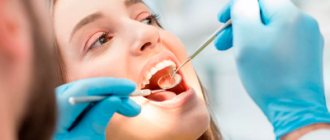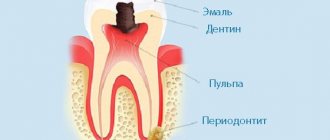Many people sooner or later face the question: “what to do if your wisdom tooth hurts very much when chewing, erupting at rest, or under other conditions.” Third molars are located at the very end of the upper and lower jaws. They are designed for chewing coarse dietary fiber, but their absence does not in any way affect the quality of food grinding and the processes occurring in the gastrointestinal tract. “Eights” have always been considered problematic and provoke unpleasant symptoms in humans. Let's look at why this happens and what to do to make this difficult period easier.
Causes of pain
Most people complain of pain during teething. Can a wisdom tooth not hurt? In rare cases, there are patients who do not experience discomfort, but this is rather an exception to the rule. Even if the crown has not yet appeared on the surface, the growth of dental units is indicated by not very pleasant sensations. Similar signs are observed with inflammation or diseases of the oral cavity. Thus, provoking factors can be both natural (related to physiology) and pathological. Let's look at the most common causes of pain.
Teething
The main symptom when a wisdom tooth comes through is that it hurts. Eights grow at different ages; the process itself usually lasts several years. Normally, all back molars should grow in by age 30.
The period is quite difficult, because the jaws of an adult are already fully formed by this time. The gums are dense and thick. The surface of the unit is wide, the upper parts are rounded, which complicates exit through soft tissue.
If the gum layer is too thick and cannot be penetrated, growth may continue in the direction of less resistance, i.e. sideways relative to the rest of the rows. Due to constant compression, a pain syndrome appears that spreads to the face, ears, and neck. If teething is prolonged, it is recommended to contact a dental clinic to resolve the issue of cutting the gums.
Inflammatory process
If teeth take too long to erupt, inflammation often occurs. It is aseptic, that is, not caused by pathogenic microorganisms. There is pain in the temporal part and ears, the cheeks and mucous membranes swell and turn red. Ulcers and erosions form on the gums. It becomes difficult to chew foods and swallow food and drinks. In some cases it is difficult to open your mouth. Other symptoms also occur: headaches, increased body temperature, and general malaise.
If bacterial microflora gets into the wound, the patient gets worse. Purulent discharge appears and flux forms. If this process is started, urgent surgical intervention by a surgeon will be required. In the absence of timely treatment, complications such as otitis media, damage to the lymph nodes, and sepsis (blood poisoning) are possible.
Pericoronitis
What to do when a wisdom tooth comes out and your gums hurt, what will help, is watchful waiting effective? Unfortunately, sometimes the process gets out of control and the fourth molar begins to grow horizontally. The gum tissue does not rise evenly, but at an angle, resulting in a pocket. Food particles and bacteria get into it. Because of this, an inflammatory process develops. It affects soft and hard tissues. If treatment is not timely, the lymph nodes become inflamed, phlegmon and other unpleasant consequences appear.
Pericoronitis is treated surgically - excess fibers above the crown and the resulting hood are removed, and food debris is cleaned out. The patient cannot do all this himself due to the inconvenient localization of the “eights”.
Caries
Carious lesions affect enamel and dentin. In the presence of a gum pocket, the blackened cavities are hidden from the human eye and therefore cannot be noticed during a routine examination. After resection, wound healing and swelling elimination, it is worth contacting the dentist again to install a filling. If you do this too late, the risk of pulpitis or periodontitis increases, the treatment of which causes a lot of inconvenience, because it is not easy to reach the back molars.
Possible complications during wisdom tooth growth
What problems await you if you don’t go to the dentist on time?
- Firstly, atypical growth of the figure eight and advanced pericoronitis can lead to deformation of the dentition and malocclusion.
- Secondly, the swelling can be so severe that the proportions of the face are disrupted, and the person cannot open his mouth even a centimeter. Against this background, the submandibular lymph nodes become enlarged and painful.
- Thirdly, any, even the slightest inflammation tends to progress. Bacterial infection and pus penetrate under the gum, affecting the deep periodontal tissues. In rare cases, sepsis (blood poisoning) and death may occur.
At risk are patients with weak immunity, a depleted body after a cold, stress or diet. So don’t put off your visit to the dentist!
More detailed information about excision of the hood of a wisdom tooth is in our article.
Growth symptoms
Before you understand what to do when your wisdom tooth is inflamed and hurts, or whether to take a painkiller, it is worth identifying the provoking factors and accompanying signs. The most common symptoms are:
- Pain syndrome. It signals the possible onset of the inflammatory process.
- Swelling, inflammation. At first they are localized at the site of the appearance of the molar, then they progress and cover the cheeks, ears, temples, and neck.
- Increased body temperature. In most cases, low-grade fever persists.
- Unpleasant sensations when swallowing food, drinks, discomfort while chewing food. It is impossible to fully open your mouth.
- Inflammation of the lymph nodes, pain when pressed.
When there is not enough space for an erupting wisdom tooth
Quite often there is a situation when the erupting wisdom tooth does not find enough space in the dentition. The tooth strives to make room for itself and tries to displace neighboring teeth. The seventh tooth is located in front of it, which transmits pressure to the sixth and so on. The teeth begin to shift, which causes pain.
What to do in this situation? The most unpleasant consequence is the possibility of crowded teeth. To prevent it, wisdom teeth are often specially removed, and the damaged bite is straightened with braces. It is quite simple to assess the prospect of whether a particular person is likely to develop crowded teeth. It is necessary to correctly assess the lower jaw and its length, assessing whether there is enough space for all the teeth, including the wisdom tooth.
Pain and its location
Pain syndrome is the main sign of problematic growth of “eights”. The nature of the sensations and the place where they are localized sometimes indicate a specific pathological process.
Gum
This symptom indicates pericoronitis and other consequences of improper eruption. Pathogenic microorganisms accumulate in gum pockets and cause serious inflammation and swelling. Subsequently, the pathology grows, spreads over large areas and penetrates deeper.
Jaw
If a wisdom tooth hurts when pressed from below or from above, this can be caused by various reasons. The most common are complications of caries, inflamed periosteum, and the location of dental units is not as required by the norms.
The space in the mouth is limited, and during active growth there is a mechanical impact on the adjacent rows, they are injured or displaced. The pain in this case can be sharp and sharp, aching, of low intensity.
Throat
If it hurts when teething, you should be wary. Most likely, the cause is a serious pathological process. The inflammation has become too extensive and has gone beyond the limits. The symptoms resemble a sore throat or stomatitis. When a similar symptom appears, homemade rinses with herbs will not help; consultation with a specialist is necessary.
Cheek
If the focus of inflammation progresses, the formation of purulent periostitis is possible. The patient notices that the lymph nodes are enlarged and the soft tissues are very swollen.
When you look at yourself in the mirror, you may find that the problem stands out noticeably. It becomes difficult to open your mouth, eat and talk. Sepsis is considered the most severe complication and is often fatal.
Ear and/or head
When a wisdom tooth becomes inflamed and hurts, the reasons (treatment in such a situation should be prescribed exclusively by a doctor) can be different, but most often this occurs when the nerve endings are pinched or damaged. The problem is associated with swelling and compression of the nerves or with the abnormal location of the dental units. Migraine is observed with an increase in body temperature and general malaise, not necessarily associated with the maxillofacial apparatus.
All cases are individual. Perhaps the patient will not have any pain, and new crowns will appear almost immediately.
Should I treat or remove my wisdom tooth?
It is better to remove a tooth if:
- he is in the wrong position. It is not involved in chewing, so if it causes inconvenience and pain, it is more advisable to remove it;
- there is no room for normal teething. A small amount of free space can cause crowding and misalignment of teeth;
- destruction of the tooth in front. If a wisdom tooth is cut incorrectly, it often puts pressure on the tooth next to it, destroying its enamel;
- destruction of the crown. A crown severely damaged by caries is quite difficult, if not impossible, to restore.
You should try to save a tooth if:
- there are no teeth in front, or they are planned to be removed soon;
- the tooth takes an active part in chewing, takes the correct place in its row;
- It is possible to fill canals for pulpitis.
Why does the wisdom tooth and gums in the area where it grows hurt terribly?
Inflammation and swelling are observed due to constant compression and injury to soft tissues by growing “eights”. There may be a release of liquid secretion (exudate), an increase in the concentration of lymphocytes and leukocytes, and the appearance of pus. Swelling becomes more extensive when bacterial microflora enters. To prevent complications, if you cannot urgently get to the dentist, you should take a painkiller and constantly rinse your mouth with antiseptic compounds.
A wisdom tooth grows into the cheek: what to do
There are many cases when a wisdom tooth grows to the side, for example, towards the cheek. These teeth are not efficient in terms of chewing food, but they are excellent at chewing the mucous membrane of the cheek. By the way, in dentistry there is the concept of “dystopic wisdom teeth.” They are understood as fully erupted eighth teeth, but which occupy an incorrect position in the dentition, for example, have a buccal position (see figure below)
Wisdom tooth growing into cheek: photo
If your wisdom tooth is cutting into your cheek, pay close attention to it. Constant chronic injury to the buccal mucosa will first necessarily lead to the development of ulcers and inflammation. But that is not all. Constant injury to the oral mucosa is a predisposing factor for the development of hyperkeratosis, leukoplakia, and benign neoplasms. The sharp edges of fillings and dentures can have the same effect if they injure and rub the mucous membrane. We hope that our article: What to do when a wisdom tooth grows and your gums hurt – was useful to you!
Sources:
1. Higher prof. the author's education in surgical dentistry, 2. Based on personal experience as a dental surgeon, 3. National Library of Medicine (USA), 4. “Pathology of wisdom teeth eruption” (Rudenko A.), 5. “Qualified removal of third molars” ( Asanami S.).
How to relieve pain at home
The most effective way to prevent wisdom tooth pain is to visit a dentist. When this is temporarily impossible, you should try to relieve pain and inflammation on your own. You can temporarily get rid of unpleasant symptoms with the help of analgesics, anti-inflammatory drugs, local anesthetics, and rinses.
Taking medications
Painkillers help cope with pain. Unfortunately, the effect of their use does not last long, up to 8 hours. The most popular tablets:
- Analgin.
- Dexalgin.
- Tempalgin.
Analgesic compounds cannot be used continuously because they cause serious adverse reactions (for example, disruption of the hematopoietic process, problems with the organs of the excretory system). In this case, the medications act urgently in one dose when the gums near the removed wisdom tooth hurt.
Ibuprofen, Nimesulide, Ibufen, Ketorol and other anti-inflammatory drugs act comprehensively, reducing pain, relieving swelling and lowering body temperature. You should not take them more than 3 times a day and on an empty stomach. Possible adverse reactions from the gastrointestinal tract, worsening blood clotting.
External gels (Kalgel, Kamistad) are very popular, which not only relieve pain, but also eliminate inflammation and disinfect. Some formulations are allowed to be used when teething milk units in infants. Solcoseryl and Cholisal have antibacterial properties and promote faster wound healing.
Rinse for pain
How to rinse and numb when a wisdom tooth hurts? Positive dynamics are observed after the procedure performed using such means as:
- Infusions, decoctions of herbs and other plants. Most often, patients choose chamomile, sage, and oak bark. By rinsing your mouth, you can quickly clean gum pockets and prevent possible infection.
- A solution of soda and salt. They help wash away purulent contents and get rid of swelling.
- Hydrogen peroxide, potassium permanganate and water. This is a homemade antiseptic composition that disinfects gums. It is necessary to carry out such manipulations as often as possible (at least 8 times a day).
Where does the figure eight grow?
It is called so because of its late eruption. If a child’s first milk teeth appear at the age of one, and molars appear before the age of twelve, then at what age do wisdom teeth grow? They will appear when the jaw bone tissue is fully formed. This period occurs between 16 and 27 years of a person’s life. In 3% of people they may appear after many years, and in 8% they do not appear at all. These are four chewing eights on the jaw - third molars, which normally are no different from the rest. Every person has rudiments, but not everyone has them.
The process is not associated with pathology; rather, the problem is that the eighth painters are considered a rudiment that does not carry a functional load.
Traditional medicine recipes
There are products that have been highly effective for decades. They do not help cope with severe cases, but provide invaluable assistance in eliminating pain and other signs of the pathological process.
Anesthetic solution
To prepare the healing composition you will need:
- clean boiled water (1 liter);
- a tablespoon of sea salt;
- 100 g of ammonia;
- 10 g camphor alcohol.
All ingredients mix well. Then a cotton pad is moistened in liquid and applied to the sore spot for 20 minutes. Regardless of how long the wisdom tooth hurts (how to relieve pain in advanced situations is discussed above), this anesthetic composition temporarily improves the patient’s condition and allows him to take a little rest from the torment before visiting the dentist.
Onion peel
All you need to do is take a few medium onions and boiling water. The peeled outer shell is poured with 0.5 liters of boiling water, the container is hermetically sealed and set aside in a dark place for about an hour.
After the specified time has passed, you need to take 2-3 tablespoons of infusion into your mouth and hold it, without swallowing, for 15 minutes. The procedure should be carried out up to 5 times a day. The product helps relieve teething symptoms and stop the progression of inflammation.
Aspen in pain
This decoction will provide invaluable help when the wisdom tooth in the upper jaw hurts, the gums are swollen and the face is swollen. It is necessary to pour aspen bark or shavings (20 g) with a glass of water, bring to a boil and boil for half an hour. Then the mixture is infused for the same amount of time to cool and filtered. You need to rinse your mouth with this liquid every time after eating.
Healing mixture
You should take:
- 15 drops of iodine;
- a teaspoon of salt;
- 1 tbsp. aloe juice (freshly squeezed).
The components are dissolved in 250 ml of clean boiled water, the mixture is brought to homogeneity. It is recommended to rinse the mouth about 3 times a day.
How to rinse your mouth after wisdom tooth removal
The first few hours after extirpation, rinsing is strictly prohibited. This can lead to the natural plug being washed away, exposing the socket and bone. If bacteria penetrate inside, alveolitis or osteomyelitis will develop.
From the second day, carefully, not intensively, rinse your mouth with various antiseptics:
- chlorhexidine;
- miramestin;
- furatsilin;
- diluted potassium permanganate.
At home, you can prepare a solution with salt, soda, and add a few drops of iodine to the water. Herbal decoctions with sage, eucalyptus, chamomile, calendula, and oak bark perfectly relieve swelling and inflammation.
What to do if a wisdom tooth grows and your jaw hurts during pregnancy
The female body is especially vulnerable during pregnancy, regardless of the period. This is due to decreased immunity, early toxicosis or gestosis, changes in hormonal levels and other reasons.
Unfortunately, expectant mothers cannot be treated according to standard regimens developed by doctors. Antibacterial drugs and painkillers containing analgesics are contraindicated for them.
In the absence of complications, it is better to opt for gels for topical use, suitable for infants. If there is an increase in body temperature, it is allowed to take paracetamol and medications based on it. The dosage should be calculated exclusively by a doctor, otherwise it can harm the fetus.
In advanced situations, it is necessary to operate on the patient and remove the pathological dental unit. Such manipulations are recommended to be carried out in the second trimester.
How long does it take for gums to heal after wisdom tooth removal?
It is impossible to answer this question unambiguously, since the answer depends on the following factors:
- difficulties of extirpation - with a simple procedure, the tissues are minimally injured, which means the hole will heal within a few days; with incisions in the gums, the tissues heal for several weeks;
- age - faster for young people;
- the presence of complications, inflammatory processes that delay healing indefinitely until the infection is eliminated;
- compliance with doctor's instructions for the rehabilitation period;
- individual characteristics of the body.
When is it time to see a doctor
So, your wisdom teeth are coming in, your gums hurt - what should you do to avoid serious complications? When an unpleasant symptom takes you by surprise, you don’t need to immediately drink handfuls of painkillers and anti-inflammatory pills. It is better to rinse your mouth well with herbal infusions, and in case of persistent pain, use local gels and make an appointment with a dentist.
If the symptoms progress, inflammation and dangerous external signs appear, it is recommended not to hesitate to visit the dental clinic for a quality diagnosis and treatment. Untimely intervention can lead to serious consequences, including extraction with complete loss of the tooth.
What to do if your wisdom tooth or gums on the lower or upper jaw hurt? First of all, it is important to establish the causes of the unpleasant symptom. If the provoking factors are of a physiological nature, it is enough to ensure high-quality oral hygiene, closely monitor your condition, eat well and rinse the inflamed mucous membranes for preventive purposes. When a problem appears due to pathology, it is important not to delay and visit a doctor as soon as possible.
Painkillers
In your home medicine cabinet you will probably find a remedy that will help relieve excruciating pain. But remember: any pill only temporarily relieves symptoms, but does not solve the problem as a whole. Therefore, you can’t put off going to the dentist!
General analgesics
It is recommended to take a tablet of Ketanov, Nurofen, Analgin, Etoricoxib or other analogues. The analgesic effect lasts from 1 to 5 hours. Sometimes the analgesic does not work. In this case, you cannot increase the dose of the drug; follow the instructions. Overdose causes poisoning and other serious complications.
Anti-inflammatory drugs
Ibuprofen, Paracetamol, Diclofenac and other anti-inflammatory drugs are also taken orally. They provide an analgesic effect and relieve fever, which often rises with problematic growth of the figure eight.
Topical ointments and gels
Gel Kamistad, Metrogyl Denta, Cholisal and the like give an analgesic, antibacterial and wound-healing effect. After application, the gums “freeze” for some time – 2-3 hours. Instead of ointment or gel, Angilex anesthetic spray is also used.
You can apply a piece of ice or something cold to the cheek where the tooth hurts. But do not overdo it - 5-7 minutes will be enough, otherwise severe hypothermia can lead to tissue necrosis.
Attention: do not take antibiotics without a doctor's prescription!










